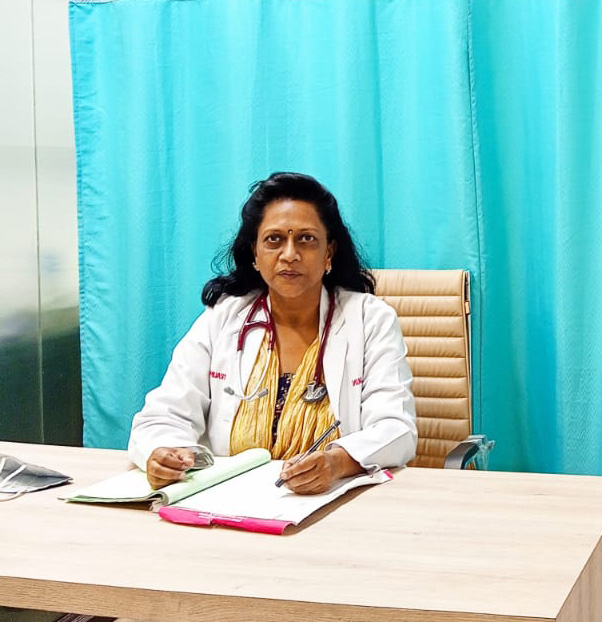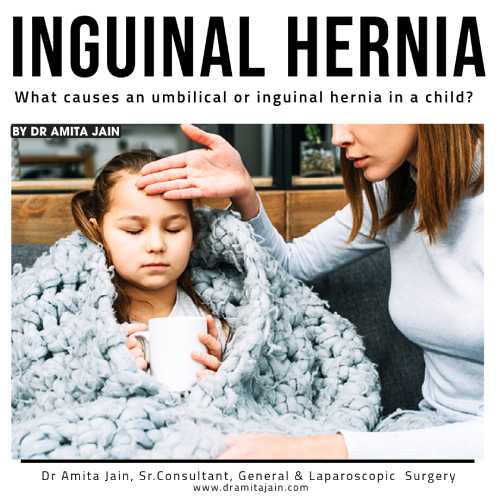As we all know, a hernia occurs when an organ or tissue protrudes through a weakened spot in the muscle or connective tissue, creating a visible bulge or lump under the skin.
In children, hernias are found commonly in two primary locations: the groin area, known as an Inguinal hernia, and around the belly button, referred to as an Umbilical hernia.
If you are wondering what causes hernia–umbilical or inguinal in a child, then, read this article to find out what Dr Amita Jain, Delhi’s top hernia specialist and laparoscopic surgeon has to share with her readers.
Let’s first try and understand the two types of hernia mentioned above.
What is inguinal hernia?
An inguinal hernia in children occurs abdominal contents, like intestines, protruding through the groin area. It affects around 2% of children, more often boys, commonly on the right side.
Premature babies are particularly susceptible. It can be congenital or develop later in life. Symptoms of an inguinal hernia in children include:
- pain and swelling in the abdominal area
- an oblong or bulging lump in the groin
- a feeling of heaviness in the abdomen
- tenderness when pressing on or moving the hernia
- nausea or vomiting, and
- difficulty urinating or defecating
What is an umbilical hernia?
An umbilical hernia in children appears as a noticeable bulge near the navel, often detected during early pediatric checkups. It commonly occurs in premature infants, with a high incidence in those weighing between 1 to 1.5 kilograms.
This hernia forms when the abdominal wall’s natural closing around the umbilical cord opening after birth is incomplete, creating a weak spot. Fortunately, most umbilical hernias in infants resolve spontaneously by age two.
What causes inguinal hernia in children?
A tunnel-like passage called the inguinal canal is present in all babies at birth, extending from the abdomen to the private parts. In boys, during fetal development, the testicles descend from the abdomen to the scrotum, pulling a sac-like extension of the abdominal lining with them (inguinal hernia into scrotum).
Normally, this connection resolves, but if it doesn’t, a hernia can occur, where a sac extends from the abdomen through the abdominal wall into the inguinal canal or even into the scrotum, surrounding the testicle.
This happens because the inguinal canal, which typically closes before birth, may remain partially open, allowing intestines or, in girls, parts of the reproductive system like an ovary, to slip through, causing a hernia.
Although less common in girls, they also have inguinal canals where hernias may occur. In some cases, the protruding intestine can become stuck, leading to potential complications if blood supply to that area is compromised.
What causes umbilical hernia in children?
With the development of the fetus in the womb, a small opening naturally forms in the abdominal muscles to accommodate the umbilical cord.
Normally, this opening should close shortly after birth. However, in some cases, especially after the umbilical cord is cut, the muscles around the belly button may not fully seal.
This incomplete closure can lead to an infant umbilical hernia, where fatty tissue or part of the bowel protrudes through this weakened area.
This condition occurs due to the muscles failing to completely close, allowing tissue from the intestines to push through.
Does your child need surgery?
Surgery is required when the intestine becomes stuck in the inguinal canal. This condition can lead to a blockage of blood supply to the intestine causing damage to the intestine.
Umbilical hernias in infants usually resolve within two years without needing treatment. Small umbilical hernias, less than half an inch in size, typically close on their own with an 85% success rate.
However, surgery may be recommended if the hernia is larger than 1.5 cm in children older than 2 years, if the intestines are trapped within the hernia causing obstruction, if there is pain or skin discoloration at the hernia site, or if the hernia remains symptomatic or fails to close by age 5.
A surgery is necessary if a hernia ruptures, although such occurrences are extremely rare.
This article has made an honest endeavor to outline the causes of umbilical and inguinal hernias in children. Whether congenital or due to incomplete muscle closure, timely medical attention ensures effective management, often resolving without surgery, except in critical cases warranting intervention.

Dr Amita Jain is a surgeon with highest degree of professional competence, precision and surgical craftsmanship. Performed all complicated general surgery procedures with in depth knowledge of invasive and few minimal invasive and onco surgical techniques. Underwent special training in trauma, executed various trauma-related complex life-saving neurosurgical procedures, reconstructed injured mangled limbs and performed vascular and reconstructive procedures with critical care.
Dr Amita Jain holds 28 plus years of rich experience in Trauma and General Laparoscopic Surgeries (including Gallbladder stone removal, appendix removal, hernia repair surgery, piles and fissure surgeries). She was the Professor Surgery of at the Army College of Medical Sciences and Base Hospital Delhi Cantt. In 1994 she was commissioned as Surgeon under the United Nations Mission in Congo. From 2020 to 2022, she worked with Bansals Hospital. Currently, Dr Amita Jain is the Senior Consultant, (Speciality: General and Laparoscopic Surgeon) at Artemis Lite Hospital, New Delhi

